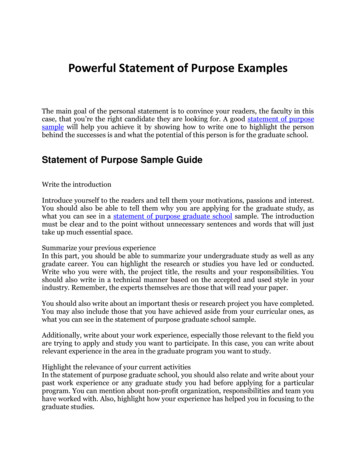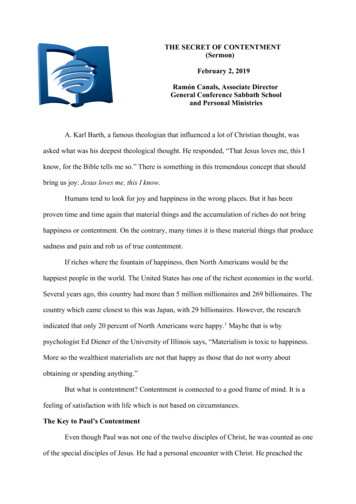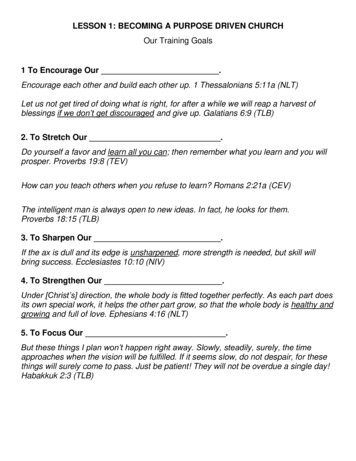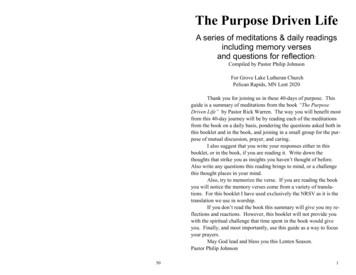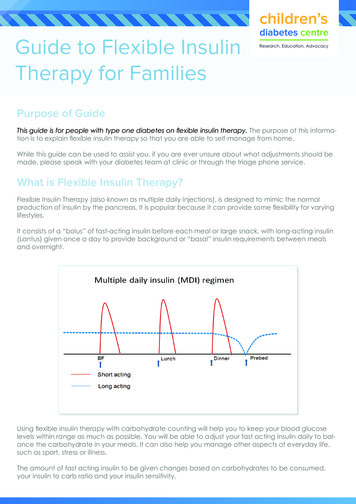
Transcription
Guide to Flexible InsulinTherapy for FamiliesPurpose of GuideThis guide is for people with type one diabetes on flexible insulin therapy. The purpose of this information is to explain flexible insulin therapy so that you are able to self-manage from home.While this guide can be used to assist you, if you are ever unsure about what adjustments should bemade, please speak with your diabetes team at clinic or through the triage phone service.What is Flexible Insulin Therapy?Flexible Insulin Therapy (also known as multiple daily injections), is designed to mimic the normalproduction of insulin by the pancreas. It is popular because it can provide some flexibility for varyinglifestyles.It consists of a “bolus” of fast-acting insulin before each meal or large snack, with long-acting insulin(Lantus) given once a day to provide background or “basal” insulin requirements between mealsand overnight.Using flexible insulin therapy with carbohydrate counting will help you to keep your blood glucoselevels within range as much as possible. You will be able to adjust your fast acting insulin daily to balance the carbohydrate in your meals. It can also help you manage other aspects of everyday life,such as sport, stress or illness.The amount of fast acting insulin to be given changes based on carbohydrates to be consumed,your insulin to carb ratio and your insulin sensitivity.
What is a carbohydrate ratio?Insulin to carbohydrate ratio (ICR) is the number of grams of carbohydrates that is covered by 1 unitof insulin. This ratio varies amongst people and can be affected by the time of the day, and changesin weight, age, exercise and other factors.Below is an example of two different ICR’s applied to the same food.This person uses an ICR of 1:5gThis means each 5g of carbs in this slice of bread requires a unit of insulin. Therefore this slice of breadwhich is 15g of carbs needs 3 units.1:5g carb ratio5g Carbohydrates1 unit5g Carbohydrates1 unit5g Carbohydrates1 unit1 unit covers 5g ofcarbohydratesEach 5g ofcarbohydratesrequires a unitof insulin Total 3 units for the slice Total 3 units for the sliceA different person uses an ICR of 1:15gThis means 1 unit will cover 15g or the whole slice of bread and the insulin dose will be lower.1:15g carb ratio1 unit covers 15g ofcarbohydratesEach 15g ofcarbohydratesrequires a unitof insulinSlice of bread 15g carbohydrates1 unit Total 1 unit for the slice
As demonstrated on the previous page, the lower the number in the ICR the larger the insulin dose.The aim is that 2 – 3 hours after a meal the blood glucose levels should be no more than 2mmol/Lhigher than before the meal.To get a general idea of what the ICR should be, the 500 rule is used. The 500 rule starts with 500, anddivides the average amount of insulin given over the last 5 days.For example: if the average daily dose of insulin over the last 5 days is 50 units:Calculation is 500 divided by 50500/ 50 carbohydrate ratio of 10.In children under 5 years the 300 rule can give a more accurate idea of the ICR. The 300 rule canalso be more useful in children and adolescence through puberty.Provides highest dose of insulinProvides lowest dose of insulinInsulin : CHO ratio (g)1.52344.556.57.5810121520253035404550556065My current insulin to carbohydrate ratio isIf my BGL is high 2 hours after the meal requiring more insulin, change to theratioIf my BGL is low 2 hours after the meal requiring less insulin, change to theratioYour diabetes teamwill help you workout your carb ratiobecause everyoneis different.
What is insulin sensitivity?Insulin sensitivity is also known as a correction factor. It controls how much extra insulin should begiven for a high blood glucose reading in order to bring your blood glucose levels into range(4 – 8mmol/L) after 2 – 3 hours.For example, a sensitivity of 2 means that 1 unit of insulin will lower the blood glucose by 2mmol/L.So if your BGL was 10mmol/L and you injected one unit, your BGL would later be 8mmol/L.The lower the sensitivity number– the more insulin will be given for a correctionTo get a general idea of what the insulin sensitivity factor is, the 100 rule is used. The 100 rule is startingwith 100, and dividing the average amount of insulin given over the last five days. For example if theaverage daily dose of insulin is 50. Calculation is 100 divide 50.100 / 50 insulin sensitivity of 2You can see if your sensitivity is correct by looking at your record book. Look at days when you havehad a high BGL before a meal and see what happened 2-3 hours later. You can also look at timeswhen you have had to give insulin without any food to correct a high level. If it over or under correctsthe insulin sensitivity needs to be changed.Provides highest dose of insulinProvides lowest dose of insulinSensitivity/Correctionfactor (mmol/L)11.31.522.533.544.5567891012141618My current insulin sensitivity ismmol/L.For more insulin for correctionsdue to high BGL’s change tommol/L.For less insulin for correctionsdue to low BGL’s changeto mmol/L.
Calculating your dose of insulinWhen you apply a carb ratio and insulin sensitivity your pre meal insulin dose will change frequently.Meters and apps are available which allow you to program different carb ratios and sensitivities atdifferent times of the day to help you calculate your insulin dose.It is common that as your insulin to carb ratio changes so may the insulin sensitivity, but this is notalways the case.Your carb ratio and insulin sensitivity should be regularly reviewed.It is important to remember that the blood glucose target is 4 – 8mmol/L.Tips for changing insulinLook at times of the day separately; different insulin to carb ratios and sensitivities across the dayis very common.Look at BGL’s 2 – 3 hours after your meals.Remember target blood glucose levels are 4.0 – 8.0 mmol/L.Make sure you are carbohydrate counting correctly before making changes.Look at patterns over three days. Do not change insulin based on one high or low level.A glucose level outside of target at the same time of the day on multiple occasions (minimum 3times) may suggest a change is needed to your carb ratio and or sensitivity.During the “honeymoon phase” your body begins to produce some of its own insulin and insulinrequirements can change very quickly. During the “honeymoon phase” changes may be madesooner before the suggested trend of three levels. Please speak to your diabetes team.When do I need to change the Lantus dose?The Lantus dose is the background insulin that is active throughout the whole day.Lantus keeps your BGL’s at a relatively similar level between going to bed and waking in themorning.If your blood glucose levels are regularly dropping by 4mmol/L or more between going to bedand waking then the Lantus needs reducing by 1-2 units.If your levels are regularly rising by more than 4mmol/L between going to bed and waking youmay need to increase Lantus by 1 – 2 units.For example if your BGL’s were 8mmol/L before bed and waking levels were 12mmol/L or morewithout having any carbohydrates then more Lantus may be needed.If you are unsure please call PMH during 8:30 – 4:30pm on 9340 8090, press 2 to speak with a diabeteseducator and leave a message with your child’s name and your preferred contact number.
The Lantus dose is the background insulin that is active throughout the whole day. Lantus keeps your BGL's at a relatively similar level between going to bed and waking in the morning. If your blood glucose levels are regularly dropping by 4mmol/L or more between going to bed and waking then the Lantus needs reducing by 1-2 units.



